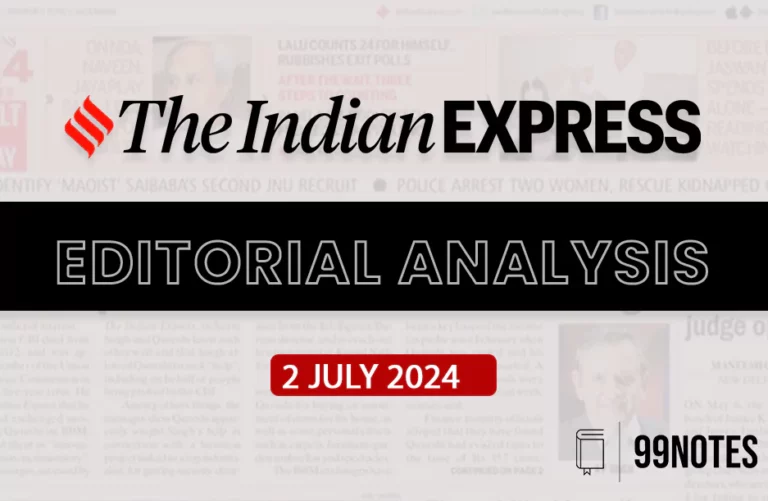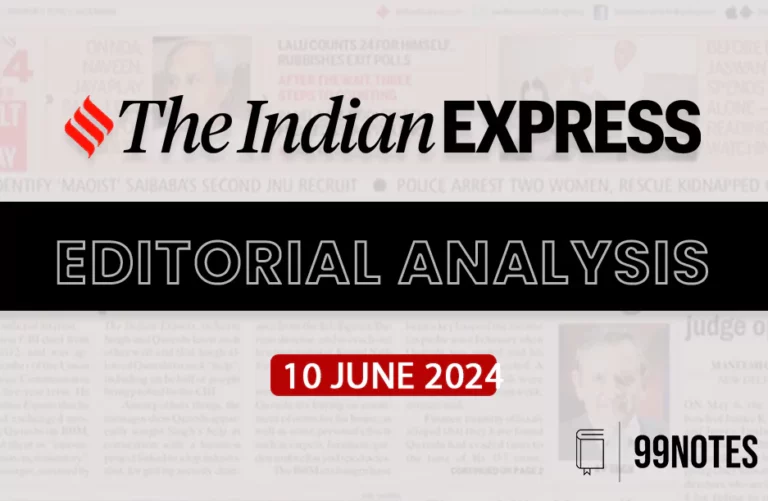7 Feb 2024 : Indian Express Editorial Analysis
Indian Express Editorial Analysis
7-February-2024
1. Policy must address growth gap
| Topic: GS3 – Indian Economy – Government Budgeting. This topic is relevant for both Prelims and Mains in the context of understanding of the country’s economic policies, challenges, and prospects. |
| Context: |
|
More about the news:
Budgetary Figures and Trends:
- In nominal terms, the budgeted total expenditure stands at Rs 47.8 lakh crore, marking a 6.1 percent increase over the revised estimates for 2023-24, which is the lowest increase in two decades.
- Capital expenditure has notably risen by 16.9 percent to Rs 11.1 lakh crore, continuing the trend seen in recent years.
- However, non-interest revenue expenditure has declined by 5.5 percent in real terms, indicating a fiscally conservative approach.
Fiscal Policy Objectives:
- The fiscal policy framework aims to reduce the debt-to-GDP ratio and mitigate the adverse effects of expenditure reduction on GDP growth.
- This strategy aligns with the recommendations of the FRBM review committee to lower the targeted debt-to-GDP ratio from the current 58 percent to 40 percent.
Factors Influencing Debt-to-GDP Ratio:
- The debt-to-GDP ratio depends on GDP growth rate relative to the interest rate and the primary deficit-GDP ratio.
- The government has been reducing its borrowing and primary deficit ratio since 2021-22 to achieve the targeted debt-to-GDP ratio.
Impact on Expenditure Growth Rate:
- Reducing the primary deficit-GDP ratio necessitates controlling the expenditure growth rate.
- The primary expenditure-GDP ratio declined from 12.7 percent in 2021-22 to 11.6 percent in 2023-24, implying a limitation on expenditure growth rate to achieve the debt-to-GDP target.
Shift in Expenditure Composition:
- To mitigate the adverse impact of expenditure reduction on GDP growth, the government has focused on shifting expenditure towards capital expenditure.
- This policy decision reflects the belief that an increase in capital expenditure has a greater multiplier effect on output compared to revenue expenditure.
Analysis of Fiscal Policy Framework:
- The fiscal policy framework raises questions regarding the advisability of an arbitrary debt-to-GDP target and the sufficiency of policy objectives to address India’s developmental challenges.
- While debt stability can be achieved at the current debt-to-GDP ratio through higher growth rates, the focus on debt reduction may not adequately address the need for structural change and employment generation.
Employment Trends and Income Distribution:
- Labour force data highlights a reversal in the process of structural change, with a significant increase in self-employment post-Covid.
- Despite GDP growth recovery, regular wages have stagnated, indicating a widening income gap and weak improvements in welfare.
- Addressing these challenges may require a reevaluation of fiscal policy targets and a focus on inclusive growth strategies.
Conclusion:
- The Interim Union Budget reflects a fiscally conservative approach aimed at debt reduction and GDP growth stabilization.
- However, questions remain regarding the effectiveness of these policies in addressing India’s developmental challenges, particularly in terms of employment generation and income distribution.
- Addressing these concerns may necessitate a reassessment of fiscal targets and a more nuanced approach to economic policy formulation.
| PYQ: Distinguish between capital budget and revenue budget. Explain the components of both these Budgets. (150 words/10m) (UPSC CSE (M) GS-3 2021) |
| Practice Question: Discuss the challenges and opportunities in achieving the stated fiscal targets amidst prevailing economic challenges and structural transformation requirements in the Indian economy. (250 words/15 m)Top of Form |
2. The dead ends of education
| Topic: GS2 – Social Justice – Education This topic is relevant for Mains in the context of understanding the complexities surrounding student suicides and the broader socio-economic context. |
| Context: |
|
More about the news:
Caste Discrimination in Elite Educational Institutions:
- In the period from 2014 to 2021, 122 students in elite engineering and management institutions committed suicide, with 68 belonging to lower-caste communities.
- This disparity underscores the role of caste discrimination, particularly in institutions where a majority of India’s population, belonging to lower castes, faces significant challenges.
Coaching Culture and Mental Health Struggles:
- The pressure-cooker environment of coaching institutions, particularly evident in places like Kota, Rajasthan, has been cited as a contributing factor to student suicides.
- High-stakes entrance exams, coupled with the financial burden and mental toll of rigorous preparation, exacerbate the struggles faced by vulnerable students.
Root Causes and Societal Pressures:
- The societal expectation of academic success, compounded by caste-based discrimination and economic disparities, creates a hostile environment for many students.
- Marginalized groups often bear the brunt of these pressures, perpetuating cycles of inequality and mental health challenges.
Education as a Tool for Empowerment:
- While education is touted as a pathway to empowerment and social mobility, its current manifestation often falls short.
- The perpetuation of caste-based discrimination, coupled with systemic inequalities, undermines the transformative potential of education.
Pedagogical Perspectives and Policy Implications:
- Various thinkers, from Gandhi to Ambedkar, have offered differing perspectives on the purpose and nature of education.
- However, a coherent pedagogical tradition remains elusive.
- There is a pressing need to reevaluate educational objectives and prioritize holistic development over rote learning and academic achievement.
Reimagining Education for the Future:
- In an increasingly complex and interconnected world, education must evolve to meet the changing needs of society.
- A renewed focus on critical thinking, empathy, and social justice is essential to cultivate responsible citizens capable of navigating the challenges of the 21st century.
Role of Educators and Stakeholders:
- Ultimately, the responsibility lies with educators, policymakers, and society as a whole to address the root causes of student suicides and create a more inclusive and supportive educational environment.
- By prioritizing mental health, fostering diversity, and challenging systemic injustices, we can work towards a brighter and more equitable future for all students.
| What are the Initiatives To Curb Suicides? |
Global Initiatives:
Indian Initiatives:
|
| PYQ: Explain why suicide among young women is increasing in Indian society. (150 words/10m) (UPSC CSE (M) GS-1 2023) |
| Practice Question: Discuss the socio-economic factors and systemic challenges contributing to the rising trend of student suicides in India. (150 words/10 m) |
For Enquiry

13 February 2024 : The Hindu Editorial Notes PD

13 Feb 2024 : Indian Express Editorial Analysis

13 February 2024 : PIB Summary for UPSC

12 Feb 2024 : Daily Current Affairs Quiz

12 Feb 2024 : Daily Answer Writing

12 Feb 2024 : Daily Current Affairs

12 Feb 2024 : Indian Express Editorial Analysis

12 February 2024 : The Hindu Editorial Notes PDF

12 February 2024 : PIB Summary for UPSC

10 Feb 2024 : Daily Current Affairs Quiz
Feb 2024 The Hindu 13 February 2024 : The Hindu Editorial Notes PD The Hindu Editorial
13-February-2024
1. A global alliance to bridge the gender equity gap
Topic:…
Indian Express 13 Feb 2024 : Indian Express Editorial Analysis Indian Express Editorial Analysis
13-February-2024
1. A science for us
Topic: GS2 – Governance…
feb 2024 PIB 13 February 2024 : PIB Summary for UPSC PIB Summary for UPSC
13-February -2024
1. Union Minister G Kishan Reddy inaugurate regional centre…
Daily Quiz 12 Feb 2024 : Daily Current Affairs Quiz 12 Feb 2024 : Daily Quiz…
mains answer writing 12 Feb 2024 : Daily Answer Writing Mains Answer Writing
12-February-2024
Q1) “Water scarcity threatens economic and social gains…
Daily Current Affairs 12 Feb 2024 : Daily Current Affairs Daily Current Affairs
12-February-2024- Top News of the Day
1. Great Indian Bustards give Nandyal a…
Indian Express 12 Feb 2024 : Indian Express Editorial Analysis Indian Express Editorial Analysis
12-February-2024
1. CLASSROOM VS COACHING
Topic: GS2 – Social…
Feb 2024 The Hindu 12 February 2024 : The Hindu Editorial Notes PDF The Hindu Editorial
12-February-2024
1. A privileged strategic partnership, without a gulf
Topic:…
feb 2024 PIB 12 February 2024 : PIB Summary for UPSC PIB Summary for UPSC
12-February -2024
1. Birth anniversary of Swami Dayanand Saraswati
Topic:…
Daily Quiz 10 Feb 2024 : Daily Current Affairs Quiz 10 Feb 2024 : Daily Quiz…





